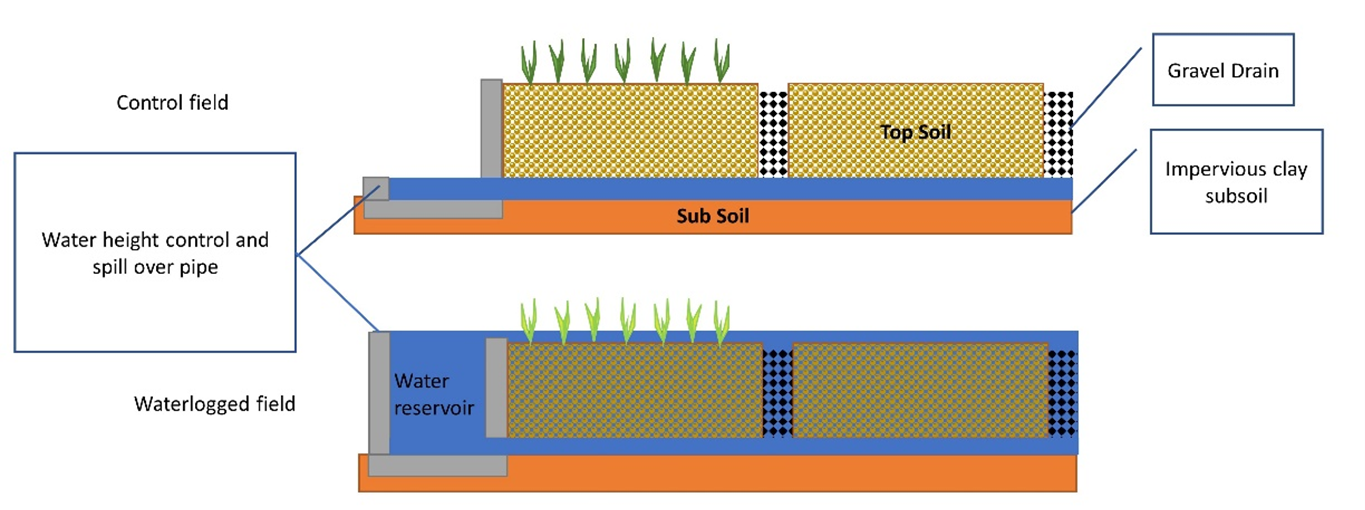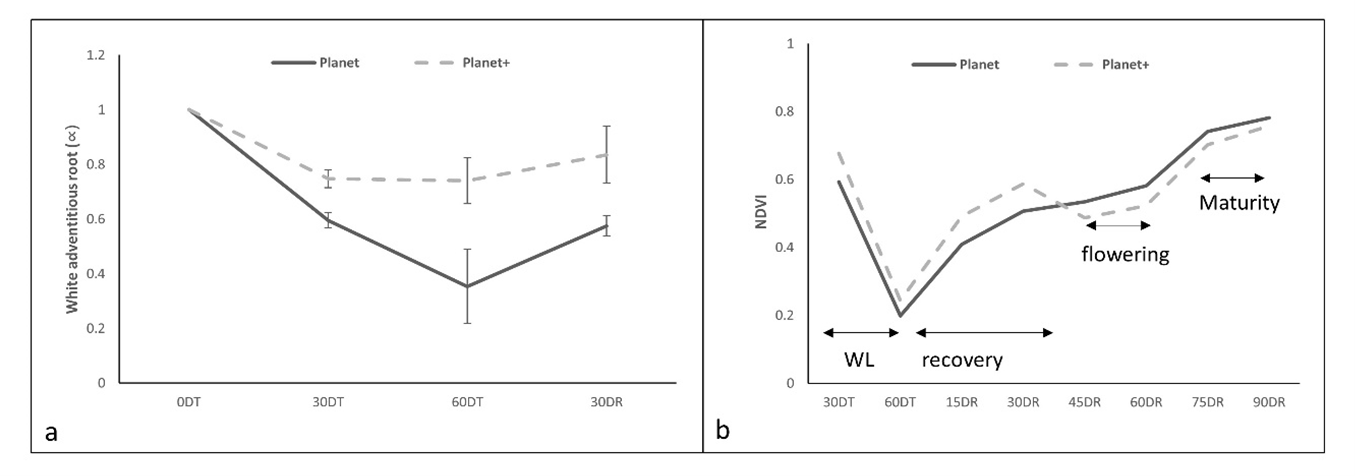Improving waterlogging tolerance of barley varieties
Author: S M Nuruzzaman Manik, Chenchen Zhao, Peter Johnson and Meixue Zhou (Tasmanian Institute of Agriculture, University of Tasmania) | Date: 24 Feb 2022
Take home messages
- Waterlogging is a serious environmental factor that limits barley yield.
- A single QTL for aerenchyma formation found in a wild barley has been introgressed into commercial variety RGT Planet to produce Planet+.
- The Planet+ lines showed 20-50% higher yielding than RGT Planet under waterlogged conditions with no significant differences under control conditions.
Background
Waterlogging is one of the major abiotic stresses in crop production (Zhou et al. 2007). Globally, an estimated 12% of crop areas are affected by waterlogging (Manik et al. 2019). By influencing crop growth and development (Kozlowski 1997; Ren et al. 2014 ), waterlogging drastically reduces barley yield (Liu et al. 2020; Manik et al. 2022). Global barley production has diminished over the last two decades, decreasing from 155Mt in 2008–2009 to 142Mt in 2017–2018 (Statista, 2020 ; Liu et al. 2020). Part of this decline is due to increased frequency of waterlogging and susceptibility of barley to waterlogging stress damage (Byrne et al. 2022). In many contexts, improving crop tolerance to low or mild waterlogging is generally cost effective. However, under severe waterlogging, combined agronomic, engineering and genetic solutions are needed (Manik et al. 2019).
Waterlogging hinders the growth of plants by reducing the dispersal of oxygen through the pore spaces in the soil around the root zone (Drew and Sisworo 1977; Armstrong 1980). Waterlogging first affects the roots and the plant root needs an adequate supply of oxygen so as to fulfill the water and nutrient requirements of the shoots. The soil oxygen concentration should be above 10% where atmospheric concentration is 21% (Colmer and Greenway 2011). Under waterlogging conditions, oxygen demand to the root tip and to the rhizosphere is supplied by forming aerenchyma through removal of some cells of the cortex and these remove excess gases from the root and soil (Armstrong 1980; Colmer and Greenway 2011). Morphological adaptations including adventitious roots with well-formed cortical aerenchyma (Figure 1) enhance internal diffusion of oxygen from shoots to the waterlogged roots, allowing roots to maintain aerobic respiration (Armstrong 1980; Zhang et al. 2015).

Figure 1. Barley normal root has an intact cortical region (left). The aerenchyma in barley root on the right is formed through removal of some cells or lysis of the cells in the cortex.
Our research has discovered a key gene in a wild barley genotype which contributes to root aerenchyma formation under waterlogging conditions, thus, to waterlogging tolerance (Zhang et al. 2015). The objectives of this study were to introgress the gene into commercial varieties and to examine the contribution and effect of the QTL for root cortical aerenchyma (RCA) formation under waterlogging stress to mitigate barley yield loss.
Materials and methods
The experiments were conducted in 2021 at the research station of the Tasmanian Institute of Agriculture, Launceston, Tasmania.
Planet is a high yielding commercial variety but is sensitive to waterlogging events. The waterlogging-tolerant wild barley (Tam407227) genotype was used as a donor parent to cross with Planet to develop waterlogging-tolerant lines (Planet+ or P+) which have a Planet background with the waterlogging tolerance gene added.
Planet, and two new Planet+ lines P-17 and P-52 were sown with three replications in 1.2m x 2m field plots in a randomised complete block design. Row spacing was 0.22m and 40 seeds were sown per row, with 0.03m between seeds. The controls were sown in well-drained beds. Waterlogging treatment was started at two-three leaf stage (Figure 2) when barley suffers the most from excess water in Australia’s high rainfall regions. The waterlogging treatment lasted for two months, the period that happens very often in these regions. After waterlogging treatment concluded, all plots were fully drained until harvest.

Figure 2. Layout of waterlogging and control treatment (Manik et al. 2022).
Root survival was determined based on the proportion of white adventitious roots at 30 days under waterlogging (30DT), 60 days under waterlogging (60DT) and 30 days after recovery (30DR). At crop maturity, all plants were taken for determination of grain yield and yield components (total number of spikes and 1000-grain weight). Grain quality of all the samples was analysed at the Australian Export Grains Innovation Centre, South Perth, Australia.
Results and discussion
Field performances and aerenchyma formation
Under waterlogging conditions, tolerant genotypes showed healthy and more green leaves than sensitive genotypes (Zhou et al. 2007). In this study, Planet+ showed better growth characteristics in the field during waterlogging and after terminating waterlogging events (Figure 3a-3f). Aerenchyma formation is the key superior characteristic of waterlogging-tolerant barley genotypes under waterlogging events (Zhang et al. 2015; Manik et al. 2022). Under waterlogging condition, P+ formed a considerably higher proportion of aerenchyma in adventitious roots than Planet (Figure 3g-3h). There was no aerenchyma formed in adventitious root under the well-drained control conditions in both P+ and Planet.

Figure 3. Left: Planet+; right: Planet. a: 60 days after waterlogging; b: one week after waterlogging terminated; c: one month after waterlogging terminated; d: two months after waterlogging terminated; e: Planet+ developed numerous adventitious roots; f: Planet has few/no adventitious roots; g-h: Planet+ formed a higher proportion of aerenchyma than Planet under waterlogging conditions.
Adventitious roots
Under waterlogging conditions, adventitious root formation is one of the tolerance mechanisms in cereals (Shabala 2011). Under waterlogging conditions, P+ produced a higher proportion of healthy white adventitious roots than Planet. At 30 days under waterlogging conditions, the proportion of white adventitious roots is significantly higher than Planet. After 60 days waterlogging, P+ kept forming white adventitious roots. In contrast, Planet showed a slow progress in adventitious root formation. At 30DR, both genotypes started to recover by forming more adventitious roots, with P+ showing a greater ability to form adventitious roots compared to Planet (Figure 4a).
Crop phenology
Waterlogging hinders barley growth and delays the phenology (Liu et al. 2020). Under waterlogging conditions, P+ showed better growth attributes than Planet. During recovery, P+ recovered earlier than Planet, thus P+ showed earlier flowering and maturity than Planet (Figure 4b).

Figure 4. a: Planet+ produced more adventitious roots during and after waterlogging; b: Planet+ showed faster recover, earlier flowering and earlier maturity than Planet after waterlogging events; 0DT: before starting waterlogging events, 30DT and 60DT: 30 days and 60 days under waterlogging events, respectively; 15DR, 30DR, 45DR, 60DR, 75DR and 90DR: 15 days, 30 days, 45 days, 60 days,75 days and 90 days recovery after terminating waterlogging events, respectively.
Grain yield components
Waterlogging treatments decreased barley grain yield by 30-70%. Waterlogging-tolerant genotypes produced 20-30% greater grain yield than susceptible genotypes (Liu et al. 2020; Manik et al. 2022) under waterlogging conditions. In this study, there were significant differences between P+ (P-17 and P-52) and Planet in grain yield and yield components under waterlogging conditions with P+ (P-17 and P-52) showing 50% higher yield than Planet (Figure 5a). Grain yield is highly associated with tiller (spike) number. P+ genotypes had more than a 50% higher spike count than Planet (Figure 5b). Thousand grain weight of P-17 is slightly lower due to the high number of spikes (Figure 5c).

Figure 5. a: Grain yield; b: Number of spike/m2; c: 1000 grain weight. P-17 and P-52 are the P+ NILs and P is RGT Planet.
Grain quality
Waterlogging affects the barley grain quality parameters (Zhou et al. 2008; Manik et al. 2022). Grain quality parameters are very important for commercialisation of barley genotypes. There was no significant difference between Planet and P+ in terms of grain quality parameters protein (Figure 6a), malt extract (Figure 6b), wort (Figure 6c) and diastatic power (Figure 6d) under control conditions. Under waterlogging conditions, diastatic power and protein were reduced compared to the control but malt and wort remained unchanged. There were no significant differences between P+ and Planet under waterlogging conditions.

Figure 6. Grain quality parameters of P+ NILs and Planet; a: protein content; b: malt extract fine grind; c: wort viscosity; d: diastatic power.
What next?
In 2022 waterlogging tolerant lines will be assessed in field trials in Tasmania, Victoria and WA with possible release in coming years.
Conclusion
The below table (Table 1) shows that:
- under non-waterlogged conditions, no differences were identified between Planet+ and Planet.
- under waterlogged conditions, Planet+ survived better and showed a quick recovery, more tillers, earlier flowering and maturity, and more importantly, 20-60% higher yield than Planet.
Table 1: Comparison of Planet and Planet+ performance parameters.
Parameters | Planet | Planet+ | |
|---|---|---|---|
1 | Crop phenology in control (non-waterlogged conditions) | Same | Same |
2 | Crop phenology in waterlogged conditions | Late recovery, a smaller number of tillers, late flowering and late maturing compared to PlanetA+ | Quick recovery, more tillers, early flowering and early maturing compared to PlanetA |
3 | Grain yield in control conditions | Same | Same |
4 | Grain yield in waterlogged conditions | 20-60% less yield than PlanetA+ | 20-60% more yield than PlanetA |
5 | Grain quality | Same | Same |
Acknowledgements
The research undertaken as part of this project is made possible by significant contributions of growers through both trial cooperation and the support of the GRDC, the author would like to thank them for their continued support.
References
Armstrong W (1980) Aeration in higher plants. Advances in Botanical Research 7, 225-332.
Byrne, T., Grant, J., Kock-Appelgren, P., Förster, L., Michel, T., Miricescu, A., ... & Barth, S. (2022). Improving phenotyping in winter barley cultivars towards waterlogging tolerance by combining field trials under natural conditions with controlled growth condition experiments. European Journal of Agronomy, 133, 126432.
Colmer TD, Greenway H (2011) Ion transport in seminal and adventitious roots of cereals during O2 deficiency. Journal of Experimental Botany 62(1), 39-57.
Drew MC, Sisworo EJ (1977) Early effects of flooding on nitrogen deficiency and leaf chlorosis in barley. New Phytologist 79(3), 567-571.
Kozlowski, T. T. (1997). Responses of woody plants to flooding and salinity. Tree Physiology, 17(7), 490-490.
Liu K, Harrison MT, Ibrahim A, Manik SMN, Johnson P, Tian X, Meinke H, Zhou M (2020) Genetic factors increasing barley grain yields under soil waterlogging. Food and Energy Security 9(4), e238.
Manik SMN, Pengilley G, Dean G, Field B, Shabala S, Zhou M (2019) Soil and crop management practices to minimize the impact of waterlogging on crop productivity. Frontiers in Plant Science 10, 140.
Manik SMN, Quamruzzaman M, Livermore M, Zhao C, Johnson P, Hunt I, Shabala S, Zhou M (2022) Impacts of barley root cortical aerenchyma on growth, physiology, yield components, and grain quality under field waterlogging conditions. Field Crops Research, doi.org/10.1016/j.fcr.2022.108461
Ren, B., Zhang, J., Li, X., Fan, X., Dong, S., Liu, P., & Zhao, B. (2014). Effects of waterlogging on the yield and growth of summer maize under field conditions. Canadian Journal of Plant Science, 94(1), 23-31.
Statista (2020). Retrieved from World barley production from 2008/2009 to 2021/2022
Shabala S (2011) Physiological and cellular aspects of phytotoxicity tolerance in plants: the role of membrane transporters and implications for crop breeding for waterlogging tolerance. New Phytologist 190(2), 289-298.
Zhang X, Shabala S, Koutoulis A, Shabala L, Johnson P, Hayes D, Nichols DS, Zhou M (2015) Waterlogging tolerance in barley is associated with faster aerenchyma formation in adventitious roots. Plant and Soil 394(1/2), 355-372.
Zhou MX, Li HB, Chen ZH, Mendham NJ (2008) Combining ability of barley flour pasting properties. Journal of Cereal Science 48(3), 789-793.
Zhou MX, Li HB, Mendham NJ (2007) Combining ability of waterlogging tolerance in barley. Crop Science 47(1), 278-284.
Contact details
S M Nuruzzaman Manik
0470 647 217
smnuruzzaman.manik@utas.edu.au
Meixue Zhou
0408 365 204
meixue.zhou@utas.edu.au
GRDC Project Code: UOT1901-001RTX,
Was this page helpful?
YOUR FEEDBACK
